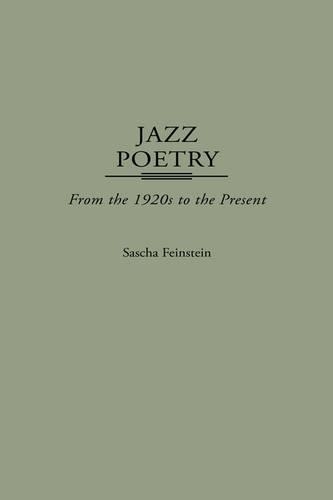
Jazz Poetry: From the 1920s to the Present
(Paperback)
Available Formats
Publishing Details
Jazz Poetry: From the 1920s to the Present
By (Author) Sascha Feinstein
Bloomsbury Publishing PLC
Praeger Publishers Inc
30th March 1997
United States
Classifications
Tertiary Education
Non Fiction
Literary studies: c 1900 to c 2000
Popular music
811.5209357
Physical Properties
Paperback
216
Width 156mm, Height 235mm
340g
Description
Embracing the entire history of jazz poetry, this work defines this inspired literary genre as poetry necessarily informed by jazz music. It discusses the major figures and various movements from the racist poems of the 1920s to contemporary times when the tone of jazz poetry experienced a dramatic change from elegy to celebration. The jazz music of Charlie Parker and John Coltrane transliterated into poetry by the likes of Langston Hughes and Sterling Brown is but part of this work. This volume should be of interest to scholars and students of literature, music, American and African studies and popular culture, as well as anyone who enjoys jazz and poetry. Emphasis is given to a call and response between white and African American writers. The earliest jazz poems by white writers from the 1920s, for example, reflected the general anxieties evoked by jazz, particulary regarding race and sexuality, and jazz did not fully become embraced in American verse until Langston Hughes and Sterling Brown published their first books in 1926 and 1932, respectively. By the 1950s, jazz poetry had become a fad, featuring jazz-and-poetry in peformance, and this text spends considerable time addressing the energetic but often widely unsuccessful work by dominantly white, West coast writers who turned to Charlie Parker as their hero. African American poets from the 1960s, however, focused more on John Coltrane and interpreted his music as a musical representation of the Black Civil Rights movement. Jazz poetry from the 1970s to the present has had less to do with this call and reponse between races, and the final two chapters discuss contemporary jazz poetry in terms of its dramatic change in tone from elegy to joy.
Reviews
The broad historical view of jazz-related poetry that Sascha Feinstein offers in Jazz Poetry is overdue, but the wait has been proven worthwhile. Feinstein's research is impressive, he has organized it intelligently, and he brings a poet's sensitivity to the scholarly discussion of complex and engaging issues.-American Book Review
This scholarly work combines interesting historical and biographical information about some of the world's greatest jazz musicians with insightful interpretations of works by an equally impressive group of poets, some of whom are not generally associated with jazz.... Students of the Harlem Renaissance will be particularly interested in the account of Vachel Lindsay's 'discovery' of Langston Hughes.... Highly recommended for upper-division undergraduates through faculty.-Choice
"The broad historical view of jazz-related poetry that Sascha Feinstein offers in Jazz Poetry is overdue, but the wait has been proven worthwhile. Feinstein's research is impressive, he has organized it intelligently, and he brings a poet's sensitivity to the scholarly discussion of complex and engaging issues."-American Book Review
"This scholarly work combines interesting historical and biographical information about some of the world's greatest jazz musicians with insightful interpretations of works by an equally impressive group of poets, some of whom are not generally associated with jazz.... Students of the Harlem Renaissance will be particularly interested in the account of Vachel Lindsay's 'discovery' of Langston Hughes.... Highly recommended for upper-division undergraduates through faculty."-Choice
Author Bio
SASCHA FEINSTEIN is Assistant Professor of English at Lycoming College and is the editor of Brilliant Corners: A Journal of Jazz & Literature. He is the coeditor (with Yusef Komunyakaa) of The Jazz Poetry Anthology (1991) and The Second Set (1996). His jazz-related poetry and prose have appeared in journals such as The Southern Review, The North American Review, and Paideuma.
